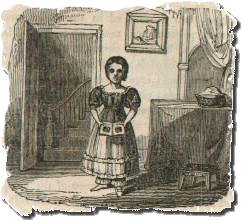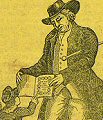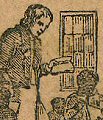NINETEENTH-CENTURY AMERICAN CHILDREN & WHAT THEY READ:
Some of Their Magazines
About 430 periodicals for children were founded in the U. S. before 1873. Learn more about them at “American Children’s Periodicals, 1789-1872,” an ever-growing descriptive bibliography.
Works on pre-1873 American children’s periodicals are listed or transcribed in a separate bibliography.
Puzzles appeared in most nineteenth-century American magazines for children. The Puzzle Drawer is a selection of puzzles printed in Woodworth’s Youth’s Cabinet and Robert Merry’s Museum. They range from the easy to one designed to be impossible. Try your wits! (And your patience!)
Samuel Goodrich created Peter Parley to help him teach children about the world; the old man with the gouty foot loved to tell stories wrapped around facts and explored every subject from natural history to metaphysics. Parley originally appeared in 1827, in Tales of Peter Parley About America, and young readers responded immediately to the old storyteller’s warmth and simple explanations. Parley’s Magazine, edited at first by Goodrich, kept up the mixture of fact and entertainment—with varying degrees of success.
The 1841 Parley’s cover is featured in a wallpaper for your desktop.
“Prospectus” (16 March 1833) lets the reader in on the editor’s intentions, which were to make the magazine so loved that children would feel punished if not allowed to read it.
About the first cover (1833) features a scan of it, and a little information; the editors of the magazine explained the cover illustrations in the welcoming “To the Public” (16 March 1833).
“The Terrified Sailors” (March 16, 1833) is a brief piece about duty and ghosts.
“Silent Companion” (30 March 1833) is a humorous tale about a surprise for a 19th-century traveler.
“Caspar Hauser” (30 March 1833) is a contemporary account of the young man reared in solitude; readers were to reflect on the wonders they took for granted. Caspar died of a knife wound nine months after this piece was published. By the time the Museum printed a story about him 17 years later, attitudes had changed considerably.
“Narrow Escape from a Bear” (27 April 1833) is a story where young man meets bear with unexpected results.
“The Little Wood-Cutter” (April 13, 1833) is a miniature example of the way Samuel Goodrich combined adventure and geography—in this case, a description of the wonders of Boston, Massachusetts, as seen by a country boy from Maine.
“I’d be a Butterfly” (28 May 1833) has a young boy learning what life is like without school. It also shows how illustrations were sometimes edited when they were reprinted.
“For My Youngest Readers” (14 September 1833), is an invitation to a bird, in the form of a poem which originally appeared in the Rose Bud; reprinting works from other periodicals was a common practice among early 19th-century American magazines.
“Mr. Durant” (14 September 1833), by James, describes a balloon ascent by Charles Ferson Durant in Albany, New York, from the viewpoint of a child.
“Fossil Shells” (7 June 1834) is a filler about a rock layer found on two continents; it’s one of the few works on fossils published in early American works for children.
“Art of Pen Making” (13 September 1834), reprinted from The Young Lady’s Book, details the process of making a quill pen, complete with a diagram.
“Story of Peter Brown” and About Edwin Finley” (20 June 1835) served as contrasting examples of behavior for boys. Unusually, the bad example isn’t completely villainous, and the good example isn’t completely angelic; and neither comes to an extreme end. The pieces do, however, emphasize education over financial cleverness.
“Walks About Boston: The Indians” (January 1836) describes the Penobscot then living in Boston.
“To Our Young Female Readers” (February 1836) briefly provides a model of female industry.
This “Joke” appeared in the June 1836 issue, p. 167:
A couple of jolly sailors just landed in New York, saw a couple of men employed in pumping the water out of a cellar. Halloo, Tom, says one of them. What is’t, says Tom. Why, said he, New York has sprung a leak, and they are pumping her out.
“Confectioners” (July 1836), by the Editor, warns young readers against the hidden dangers of sweets, which could lead to addictions both bestial and vile—seriously!
“Juvenile Celebration of Independence” (August 1836) describes a quiet celebration by some students, contrasting it with the rowdier celebration of their friends.
Two pieces about fireworks (September & October 1836) describe what went into “artificial fire works” in 1836 and how children could make a safer version.
The New Year’s address for 1838 (January 1838) discussed European Christmas and Twelfth Day celebrations, and offered readers perhaps the best possible wishes for the new year.
“Gleanings and Recollections: The New York Fire” (January 1838), by Eliza Leslie, describes the destruction of New York City’s business district by fire, on December 16-17, 1835. Cold weather hampered firemen already exhausted from fires the night before. At least 500-700 businesses were lost, and the insurance industry was bankrupted, as losses mounted to over $15 million.
“A Visit from St. Nicholas” (December 1838) is a reprinting of a poem already familiar to young readers.
“The Dying Boy” (January 1839), by “Mrs. Larned of Providence,” is a sentimental warning against alcohol, apparently based on the true story of a family’s death. It’s also one of the most morbid poems in American literature.
“The Fireside” (March 1839), apparently reprinted from a British work, explores the nature and use of coal which is, the author assures us, the remains of forests uprooted by the Deluge; the biblical Flood was often used as an explanation for the Earth’s changes, in works on fossils in early American works for children.
“Who Filled the Coal Hole?” (February 1843), reprinted from a British work, drops the Deluge as an explanation for how coal was formed and stretches the age of the Earth from 6000 to over 60,000 years, as works on fossils in early American works for children began to acknowledge that the biblical creation story was not to be taken literally.
Short-lived as it was, The Slave’s Friend was designed for maximum impact, mingling Christian and anti-slavery messages in 16-page tracts with two illustrations each. Issues are presented here in their entirety.
To “Nineteenth-Century American Children & What They Read”
Some of the children | Some of their books | Some of their magazines
Some works for adults, 1800-1872


